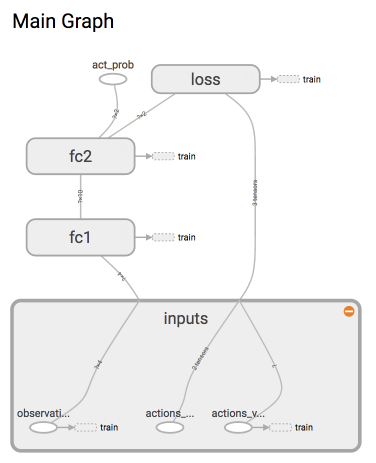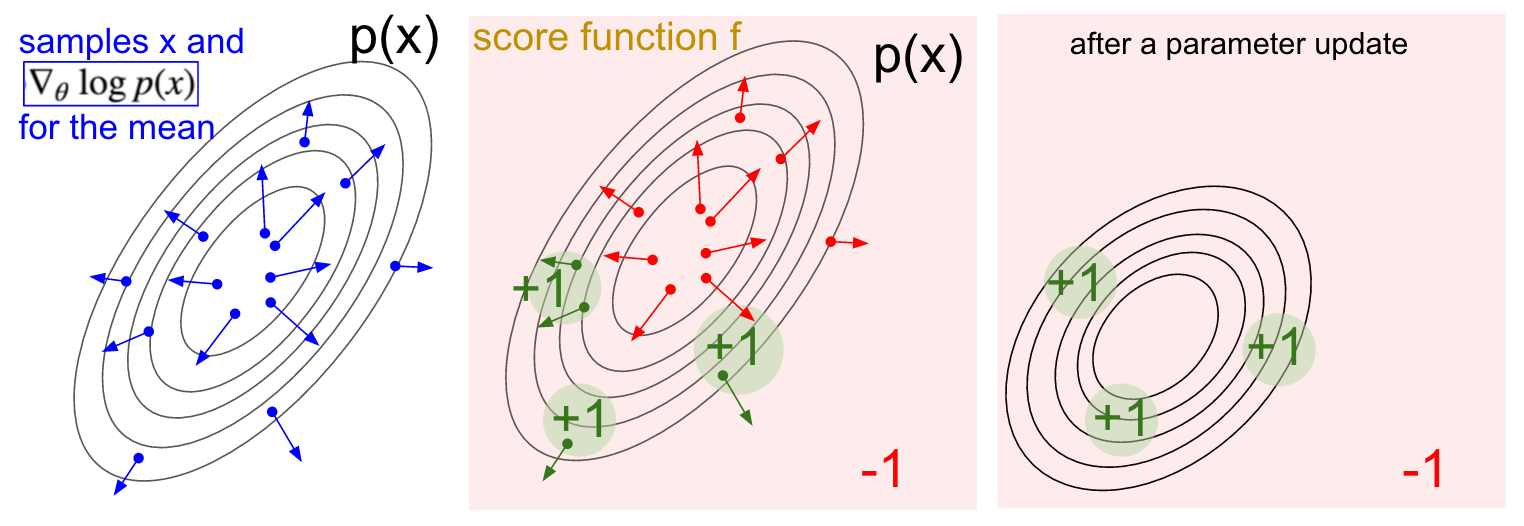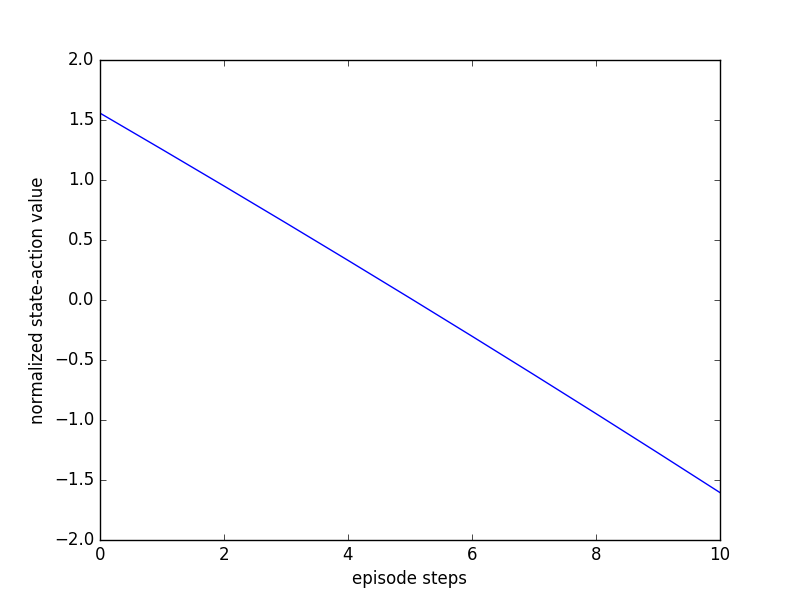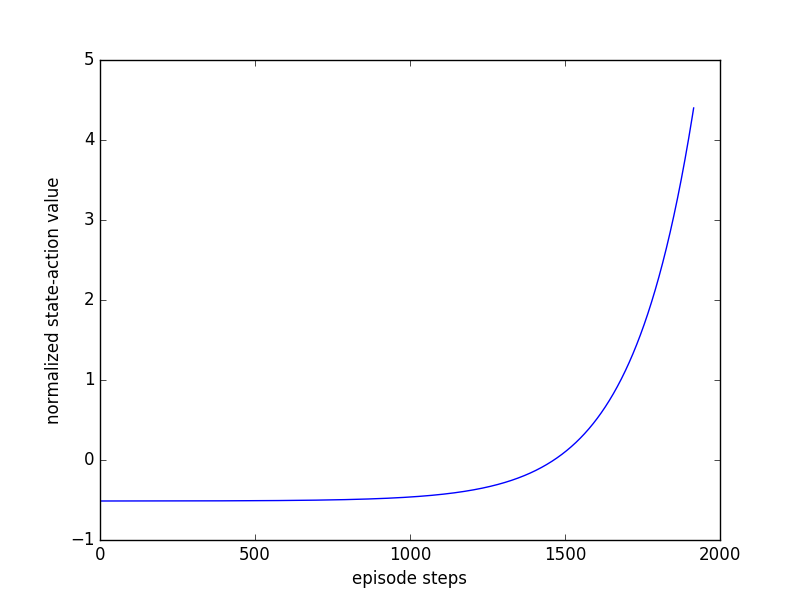Policy Gradients 思维决策 (Tensorflow)
学习资料:
- 全部代码
- 什么是 Policy Gradient 短视频
- 模拟视频效果Youtube, Youku
- 强化学习实战
- 论文 Policy gradient methods for reinforcement learning with function approximation.
接着上节内容, 我们来实现 RL_brain 的 PolicyGradient 部分, 这也是 RL 的大脑部分, 负责决策和思考.
要代码主结构 ¶
用基本的 Policy gradient 算法, 和之前的 value-based 算法看上去很类似.
class PolicyGradient:
# 初始化 (有改变)
def __init__(self, n_actions, n_features, learning_rate=0.01, reward_decay=0.95, output_graph=False):
# 建立 policy gradient 神经网络 (有改变)
def _build_net(self):
# 选行为 (有改变)
def choose_action(self, observation):
# 存储回合 transition (有改变)
def store_transition(self, s, a, r):
# 学习更新参数 (有改变)
def learn(self, s, a, r, s_):
# 衰减回合的 reward (新内容)
def _discount_and_norm_rewards(self):
初始化 ¶
初始化时, 我们需要给出这些参数, 并创建一个神经网络.
class PolicyGradient:
def __init__(self, n_actions, n_features, learning_rate=0.01, reward_decay=0.95, output_graph=False):
self.n_actions = n_actions
self.n_features = n_features
self.lr = learning_rate # 学习率
self.gamma = reward_decay # reward 递减率
self.ep_obs, self.ep_as, self.ep_rs = [], [], [] # 这是我们存储 回合信息的 list
self._build_net() # 建立 policy 神经网络
self.sess = tf.Session()
if output_graph: # 是否输出 tensorboard 文件
# $ tensorboard --logdir=logs
# http://0.0.0.0:6006/
# tf.train.SummaryWriter soon be deprecated, use following
tf.summary.FileWriter("logs/", self.sess.graph)
self.sess.run(tf.global_variables_initializer())
建立 Policy 神经网络 ¶
这次我们要建立的神经网络是这样的:
因为这是强化学习, 所以神经网络中并没有我们熟知的监督学习中的 y label. 取而代之的是我们选的 action.
class PolicyGradient:
def __init__(self, n_actions, n_features, learning_rate=0.01, reward_decay=0.95, output_graph=False):
...
def _build_net(self):
with tf.name_scope('inputs'):
self.tf_obs = tf.placeholder(tf.float32, [None, self.n_features], name="observations") # 接收 observation
self.tf_acts = tf.placeholder(tf.int32, [None, ], name="actions_num") # 接收我们在这个回合中选过的 actions
self.tf_vt = tf.placeholder(tf.float32, [None, ], name="actions_value") # 接收每个 state-action 所对应的 value (通过 reward 计算)
# fc1
layer = tf.layers.dense(
inputs=self.tf_obs,
units=10, # 输出个数
activation=tf.nn.tanh, # 激励函数
kernel_initializer=tf.random_normal_initializer(mean=0, stddev=0.3),
bias_initializer=tf.constant_initializer(0.1),
name='fc1'
)
# fc2
all_act = tf.layers.dense(
inputs=layer,
units=self.n_actions, # 输出个数
activation=None, # 之后再加 Softmax
kernel_initializer=tf.random_normal_initializer(mean=0, stddev=0.3),
bias_initializer=tf.constant_initializer(0.1),
name='fc2'
)
self.all_act_prob = tf.nn.softmax(all_act, name='act_prob') # 激励函数 softmax 出概率
with tf.name_scope('loss'):
# 最大化 总体 reward (log_p * R) 就是在最小化 -(log_p * R), 而 tf 的功能里只有最小化 loss
neg_log_prob = tf.nn.sparse_softmax_cross_entropy_with_logits(logits=all_act, labels=self.tf_acts) # 所选 action 的概率 -log 值
# 下面的方式是一样的:
# neg_log_prob = tf.reduce_sum(-tf.log(self.all_act_prob)*tf.one_hot(self.tf_acts, self.n_actions), axis=1)
loss = tf.reduce_mean(neg_log_prob * self.tf_vt) # (vt = 本reward + 衰减的未来reward) 引导参数的梯度下降
with tf.name_scope('train'):
self.train_op = tf.train.AdamOptimizer(self.lr).minimize(loss)
这里有必要解释一下为什么我们使用的 loss= -log(prob)*vt 当做 loss,
因为下面有很多评论说这里不理解.
简单来说, 上面提到了两种形式来计算 neg_log_prob, 这两种形式是一模一样的, 只是第二个是第一个的展开形式. 如果你仔细看第一个形式, 这不就是在神经网络分类问题中的 cross-entropy 嘛!
使用 softmax 和神经网络的最后一层 logits 输出和真实标签 (self.tf_acts) 对比的误差. 并将神经网络的参数按照这个真实标签改进.
这显然和一个分类问题没有太多区别. 我们能将这个 neg_log_prob 理解成 cross-entropy 的分类误差. 分类问题中的标签是真实 x 对应的 y,
而我们 Policy gradient 中, x 是 state, y 就是它按照这个 x 所做的动作号码. 所以也可以理解成, 它按照 x 做的动作永远是对的 (出来的动作永远是正确标签),
它也永远会按照这个 “正确标签” 修改自己的参数. 可是事实却不是这样, 他的动作不一定都是 “正确标签”, 这就是强化学习(Policy gradient)和监督学习(classification)的不同.
为了确保这个动作真的是 “正确标签”, 我们的 loss 在原本的 cross-entropy 形式上乘以 vt, 用 vt 来告诉这个 cross-entropy 算出来的梯度是不是一个值得信任的梯度.
如果 vt 小, 或者是负的, 就说明这个梯度下降是一个错误的方向, 我们应该向着另一个方向更新参数, 如果这个 vt 是正的, 或很大, vt 就会称赞 cross-entropy 出来的梯度,
并朝着这个方向梯度下降. 下面有一张从 karpathy 大神 网页上扣下来的图, 也正是阐述的这个思想.
而不明白为什么是 loss=-log(prob)*vt 而不是 loss=-prob*vt 的朋友们, 下面留言有很多问道这个问题.
原因是这里的 prob 是从 softmax 出来的, 而计算神经网络里的所有参数梯度, 使用到的就是 cross-entropy,
然后将这个梯度乘以 vt 来控制梯度下降的方向和力度. 而我上面使用 neg_log_prob 这个名字只是为了区分这不是真正意义上的 cross-entropy, 因为标签不是真标签.
我在下面提供一些扩展链接.
选行为 ¶
这个行为不再是用 Q value 来选定的, 而是用概率来选定. 即使不用 epsilon-greedy, 也具有一定的随机性.
class PolicyGradient:
def __init__(self, n_actions, n_features, learning_rate=0.01, reward_decay=0.95, output_graph=False):
...
def _build_net(self):
...
def choose_action(self, observation):
prob_weights = self.sess.run(self.all_act_prob, feed_dict={self.tf_obs: observation[np.newaxis, :]}) # 所有 action 的概率
action = np.random.choice(range(prob_weights.shape[1]), p=prob_weights.ravel()) # 根据概率来选 action
return action
存储回合 ¶
这一部很简单, 就是将这一步的 observation, action, reward 加到列表中去.
因为本回合完毕之后要清空列表, 然后存储下一回合的数据, 所以我们会在 learn() 当中进行清空列表的动作.
class PolicyGradient:
def __init__(self, n_actions, n_features, learning_rate=0.01, reward_decay=0.95, output_graph=False):
...
def _build_net(self):
...
def choose_action(self, observation):
...
def store_transition(self, s, a, r):
self.ep_obs.append(s)
self.ep_as.append(a)
self.ep_rs.append(r)
学习 ¶
本节的 learn() 很简单, 首先我们要对这回合的所有 reward 动动手脚, 使他变得更适合被学习.
第一就是随着时间推进, 用 gamma 衰减未来的 reward, 然后为了一定程度上减小 policy gradient 回合 variance,
我们标准化回合的 state-action value 依据在 Andrej Karpathy 的 blog.
class PolicyGradient:
def __init__(self, n_actions, n_features, learning_rate=0.01, reward_decay=0.95, output_graph=False):
...
def _build_net(self):
...
def choose_action(self, observation):
...
def store_transition(self, s, a, r):
...
def learn(self):
# 衰减, 并标准化这回合的 reward
discounted_ep_rs_norm = self._discount_and_norm_rewards() # 功能再面
# train on episode
self.sess.run(self.train_op, feed_dict={
self.tf_obs: np.vstack(self.ep_obs), # shape=[None, n_obs]
self.tf_acts: np.array(self.ep_as), # shape=[None, ]
self.tf_vt: discounted_ep_rs_norm, # shape=[None, ]
})
self.ep_obs, self.ep_as, self.ep_rs = [], [], [] # 清空回合 data
return discounted_ep_rs_norm # 返回这一回合的 state-action value
我们再来看看这个 discounted_ep_rs_norm 到底长什么样, 不知道大家还记不记得上节内容的这一段:
vt = RL.learn() # 学习, 输出 vt, 我们下节课讲这个 vt 的作用
if i_episode == 0:
plt.plot(vt) # plot 这个回合的 vt
plt.xlabel('episode steps')
plt.ylabel('normalized state-action value')
plt.show()
我们看看这一段的输出, vt 也就是 discounted_ep_rs_norm, 看他是怎么样诱导我们的 gradient descent.
可以看出, 左边一段的 vt 有较高的值, 右边较低, 这就是 vt 在说:
“请重视我这回合开始时的一系列动作, 因为前面一段时间杆子还没有掉下来. 而且请惩罚我之后的一系列动作, 因为后面的动作让杆子掉下来了” 或者是
“我每次都想让这个动作在下一次增加被做的可能性 (grad(log(Policy))),
但是增加可能性的这种做法是好还是坏呢?
这就要由 vt 告诉我了, 所以后段时间的 增加可能性 做法并没有被提倡, 而前段时间的
增加可能性 做法是被提倡的.”
这样 vt 就能在这里 loss = tf.reduce_mean(log_prob * self.tf_vt)
诱导 gradient descent 朝着正确的方向发展了.
如果你玩了下 MountainCar 的模拟程序, 你会发现 MountainCar 模拟程序中的 vt 长这样:
这张图在说: “请重视我这回合最后的一系列动作, 因为这一系列动作让我爬上了山. 而且请惩罚我开始的一系列动作, 因为这些动作没能让我爬上山”.
也是通过这些 vt 来诱导梯度下降的方向.
最后是如何用算法实现对未来 reward 的衰减.
class PolicyGradient:
def __init__(self, n_actions, n_features, learning_rate=0.01, reward_decay=0.95, output_graph=False):
...
def _build_net(self):
...
def choose_action(self, observation):
...
def store_transition(self, s, a, r):
...
def learn(self):
...
def _discount_and_norm_rewards(self):
# discount episode rewards
discounted_ep_rs = np.zeros_like(self.ep_rs)
running_add = 0
for t in reversed(range(0, len(self.ep_rs))):
running_add = running_add * self.gamma + self.ep_rs[t]
discounted_ep_rs[t] = running_add
# normalize episode rewards
discounted_ep_rs -= np.mean(discounted_ep_rs)
discounted_ep_rs /= np.std(discounted_ep_rs)
return discounted_ep_rs
如果想一次性看到全部代码, 请去我的 Github
分享到:
![]()
![]()
![]()
![]()
如果你觉得这篇文章或视频对你的学习很有帮助, 请你也分享它, 让它能再次帮助到更多的需要学习的人.
UnityTutorial没有正式的经济来源, 如果你也想支持 UnityTutorial 并看到更好的教学内容, 赞助他一点点, 作为鼓励他继续开源的动力.



